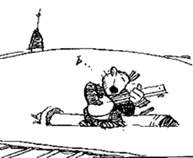
Numerical Methods & Linear Algebra
Math 2890-003
Spring 2016 Homework
Chapter 2 — Due Feb 23
- (1 point) Let \[A=\left(\begin{array}{rrr} -5 & -1 & 9 \\ -8 & -1 & 6 \\ -3 & -3 & -2 \\ -4 & -1 & -6 \end{array}\right).\] Find $A^T$, the transpose of $A$.
- (1 point) Let \[A= \left( \begin{array}{rrrrr} 0 & 5 & -1 & 4 & -6 \\ 5 & 8 & -2 & 3 & -9 \\ -1 & -2 & -9 & 7 & 3 \\ 4 & 3 & 7 & 4 & -1 \\ -6 & -9 & 3 & -1 & 7 \end{array} \right).\] Is $A$ symmetric? Explain your answer.
- (1 point) Let \[A= \frac{1}{2} \left( \begin{array}{rrrr} -1 & 1 & 1 & -1 \\ -1 & -1 & 1 & 1 \\ 1 & -1 & -1 & 1 \\ 1 & 1 & -1 & -1 \end{array} \right).\] Is $A$ orthogonal? Explain your answer.
- (3 points)
For each of the following matrices, find the inverse if it exists. Show your work.
- $A=\left(\begin{array}{rrr} 1 & 1 & 3 \\ -1 & 0 & -3 \\ -6 & -6 & -17 \end{array}\right)$.
- $B=\left(\begin{array}{rrr} 1 & 4 & 7 \\ 0 & 1 & 2 \\ 0 & 0 & 1 \end{array}\right)$.
- $C=\left(\begin{array}{rrr} 3 & -9 & 1 \\ -5 & 1 & 0 \\ 1 & 0 & 0 \end{array}\right)$.
- (1 point) Let \[A=\left(\begin{array}{rrr} 1 & 4 & 9 \\ 0 & 6 & 4 \\ 7 & 4 & 5 \\ -2 & 4 & 4 \\ -7 & -7 & -1 \end{array}\right)\quad\text{and}\quad B = \left(\begin{array}{rrr} 8 & 4 & 6 \\ 1 & -3 & 0 \\ 6 & -5 & 5 \\ -4 & 9 & -4 \\ 8 & -3 & -8 \end{array}\right).\] Compute the sum $A+B$ (showing your work) if it is defined; otherwise, explain why it is not defined.
- (1 point) Let \[A=\left(\begin{array}{rrr} -6 & -3 & 1 \\ 1 & -1 & -6 \\ 8 & 1 & 9 \\ -7 & -8 & -3 \end{array}\right)\quad\text{and}\quad v = \left(\begin{array}{r} 7 \\ -3 \\ 6 \end{array}\right).\] Compute the product $Av$ (showing your work) if it is defined; otherwise, explain why it is not defined.
- (1 point) Let \[v=\left(\begin{array}{rrrrr} 4 & -7 & -1 & 2 & 3 \end{array}\right)\quad\text{and}\quad A = \left(\begin{array}{rrr} 0 & -3 & -9 \\ 2 & -1 & 4 \\ 2 & 5 & -1 \\ 4 & 1 & 2 \\ -6 & 7 & 7 \end{array}\right).\] Compute the product $vA$ (showing your work) if it is defined; otherwise, explain why it is not defined.
- (1 point) Let \[A=\left(\begin{array}{rr} 9 & -1 \\ 7 & -2 \\ -3 & -7 \end{array}\right)\quad\text{and}\quad B = \left(\begin{array}{rrrr} -2 & 8 & -3 & 8 \\ -3 & 7 & -6 & 8 \end{array}\right).\] Compute the product $AB$ (showing your work) if it is defined; otherwise, explain why it is not defined.
- Suppose $A$ is a $25\times 17$ matrix and $B$ is a $17\times 39$ matrix. What size is the product $AB$ if it is defined? Explain your answer.
- Let \[A=\left(\begin{array}{rrr} 1 & -8 & -4 \\ -3 & 8 & -5 \\ 1 & -4 & 8 \\ 3 & -1 & 5 \end{array}\right)\quad\text{and}\quad B = \left(\begin{array}{rrrr} -3 & -4 & 1 & 7 \\ 3 & -8 & -6 & 4 \\ 9 & -6 & -4 & -5 \end{array}\right).\] Compute column 4 of the product $AB$ by first writing it as a linear combination of the columns of $A$. Show your work.
- (1 point) Let \[A=\left(\begin{array}{rrrr} 6 & -7 & 2 & -3 \\ 5 & -8 & 3 & -7 \\ 8 & -8 & 5 & -2 \end{array}\right)\quad\text{and}\quad B = \left(\begin{array}{rrr} 8 & 8 & 0 \\ -2 & -9 & -9 \\ -3 & -5 & 7 \\ -9 & 1 & 7 \end{array}\right).\] Compute row 3 of the product $AB$ by first writing it as a linear combination of the rows of $B$. Show your work.
- (1 point) Let \[A=\left(\begin{array}{rrr} -7 & -1 & 0 \\ 5 & 4 & -4 \\ -3 & -6 & -2 \end{array}\right)\quad\text{and}\quad B = \left(\begin{array}{rrrrr} 6 & 4 & 9 & 0 & 1 \\ 3 & -9 & 0 & -1 & 4 \\ -5 & 7 & -1 & -9 & 9 \end{array}\right).\] Compute the entry in row 2, column 4 of the product $AB$. Show your work.
- (1 point) Let \[A=\left(\begin{array}{rrr} -7 & -4 & 6 \\ 9 & -1 & 2 \\ 4 & -4 & 3 \\ 8 & 2 & -9 \end{array}\right)\quad\text{and}\quad B = \left(\begin{array}{rrrr} 9 & -7 & -5 & 7 \\ -9 & 1 & -6 & 6 \\ -3 & -4 & -7 & -3 \end{array}\right).\] Write the product $AB$ as a sum of $3$ rank one matrices. Show your work.
- (1 point) Let \[A = \left(\begin{array}{rrrrrr} -4 & 3 & 4 & 0 & 9 & -6 \\ -4 & -1 & 20 & 16 & -3 & -14 \\ 3 & 3 & -24 & -21 & 9 & 15 \\ 1 & -1 & 0 & 1 & -3 & 1 \\ 4 & 5 & -36 & -32 & 15 & 22 \end{array}\right).\] Find the rank of the matrix $A$. Explain your answer.
- (1 point) Let \[A=\left(\begin{array}{rrrr} 2 & 4 & 0 & -2 \\ 10 & 22 & -5 & -14 \\ 8 & 8 & 15 & 6 \\ 6 & 4 & 20 & 6 \end{array}\right)\ L=\left(\begin{array}{rrrr} 1 & 0 & 0 & 0 \\ 5 & 1 & 0 & 0 \\ 4 & -4 & 1 & 0 \\ 3 & -4 & 0 & 1 \end{array}\right)\ U=\left(\begin{array}{rrrr} 2 & 4 & 0 & -2 \\ 0 & 2 & -5 & -4 \\ 0 & 0 & -5 & -2 \\ 0 & 0 & 0 & -4 \end{array}\right)\text{ and } b=\left(\begin{array}{r} -8 \\ -60 \\ 24 \\ 88 \end{array}\right).\] Use the LU factorization $A=LU$ to solve the matrix equation $Ax=b$. Show your work.
- (1 point) Let \[A=\left(\begin{array}{rrrr} 3 & -2 & 0 & 2 \\ 15 & -11 & 3 & 15 \\ 9 & -8 & 1 & 11 \\ 15 & -10 & 10 & 15 \end{array}\right).\] Use Gaussian Elimination (or Wedderburn rank reduction) to find the LU factorization of the matrix $A$. Show your work.
- (1 point) Let \[A=\left(\begin{array}{rrrr} 6 & 6 & 6 & -25 \\ 2 & 9 & -3 & -16 \\ 10 & 0 & 15 & -15 \\ 4 & -12 & -6 & -2 \end{array}\right).\] Use Gaussian Elimination with Partial Pivoting (or Wedderburn rank reduction) to find a permuted LU (or permuted LDU) factorization of the matrix $A$. Show your work.
- (2 points)
Let \[A=\left(\begin{array}{rrrrr} 1 & -1 & 5 & 0 & -18 \\ -4 & 4 & -19 & -5 & 59 \\ -4 & 4 & -20 & 1 & 74 \\ -1 & 1 & -8 & 12 & 51 \\ 1 & -1 & 4 & 10 & 5 \end{array}\right)\quad\text{and}\quad v=\left(\begin{array}{r} -2 \\ 5 \\ 10 \\ 10 \\ 32 \end{array}\right).\]
- Is $v$ in the column space of $A$? Show your work.
- Is $v$ in the null space of $A$? Show your work.
- (2 points)
Let \[A = \left(\begin{array}{rrrrr} 1 & 4 & -4 & -6 & 13 \\ 2 & 0 & 0 & 4 & -6 \\ 2 & -3 & 3 & 10 & -18 \\ -1 & -1 & 1 & 0 & -1 \\ 2 & 2 & -2 & 0 & 2 \end{array}\right).\]
- Find a nonzero vector in the column space of $A$. Show your work.
- Find a nonzero vector in the null space of $A$. Show your work.
- (1 point)
Let \[A = \left(\begin{array}{rrrrrr} -5 & 5 & 2 & 25 & 18 & -2 \\ -2 & 0 & 2 & 10 & 2 & -1 \\ -2 & -4 & 4 & 8 & -8 & -4 \\ -5 & -3 & 5 & 16 & -1 & 0 \\ 2 & 2 & 0 & 6 & 0 & -2 \end{array}\right).\]
Find bases for Col$(A)$ and Nul$(A)$.
Hint: The reduced row echelon form of $A$ is \[\left(\begin{array}{rrrrrr} 1 & 0 & 0 & 0 & -2 & 0 \\ 0 & 1 & 0 & 3 & 2 & 0 \\ 0 & 0 & 1 & 5 & -1 & 0 \\ 0 & 0 & 0 & 0 & 0 & 1 \\ 0 & 0 & 0 & 0 & 0 & 0 \end{array}\right).\] - (1 point)
Let \[A = \left(\begin{array}{rrrrr} 58 & -15 & -144 & -204 & 11 \\ 101 & -27 & -249 & -357 & -4 \\ -45 & 12 & 111 & 159 & 1 \\ 15 & -4 & -37 & -53 & 0 \end{array}\right).\]
Find bases for Col$(A)$, Nul$(A)$, Col$(A^T)$ and Nul$(A^T)$.
Hint: If you form the matrix $(A|I)$ and use row operations to put the $A$ part in reduced row echelon form you get $(R|S)$ where \[R=\left(\begin{array}{rrrrr} 1 & 0 & -3 & -3 & 0 \\ 0 & 1 & -2 & 2 & 0 \\ 0 & 0 & 0 & 0 & 1 \\ 0 & 0 & 0 & 0 & 0 \end{array}\right),\quad S=\left(\begin{array}{rrrr} 1 & 3 & 1 & -21 \\ 4 & 13 & 8 & -79 \\ -1 & -7 & -16 & 3 \\ 1 & 7 & 17 & 0 \end{array}\right).\]
Back to assignments or home page.
